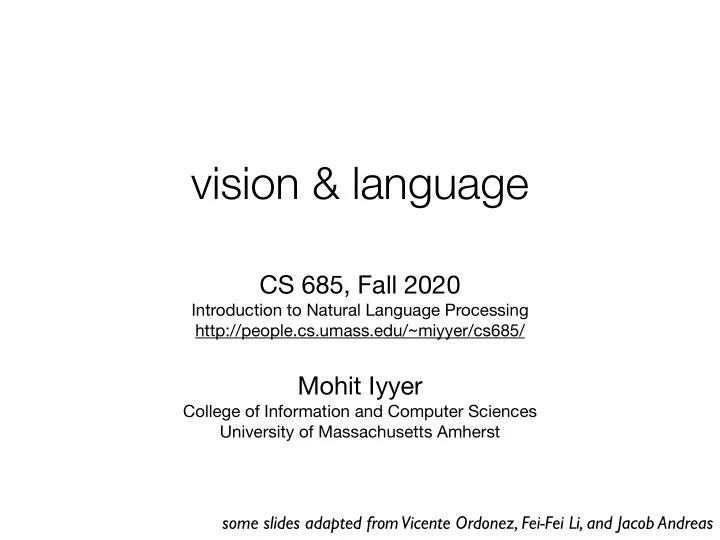

vision & language CS 685, Fall 2020 Introduction to Natural Language Processing http://people.cs.umass.edu/~miyyer/cs685/ Mohit Iyyer College of Information and Computer Sciences University of Massachusetts Amherst some slides adapted from Vicente Ordonez, Fei-Fei Li, and Jacob Andreas
Next week • Tues (11/3): exam review, will go over some important topics, quiz questions, prev. exam questions • Thu (11/5): no class, work on your exams • We’ll release an overleaf link • You’re highly encouraged to type out your answers (in LaTeX or with some word processing software); we will also accept hand-written answers if necessary • Exam will be released at 8AM Thursday, due 8AM Saturday (US Eastern time) on Gradescope
image captioning a red truck is parked on a street lined with trees 3
visual question answering • Is this truck considered “vintage”? • Does the road look new? • What kind of tree is behind the truck? 4
we’ve seen how to compute representations of words and sentences. what about images?
grayscale images are matrices What we see What a computer sees what range of values can each pixel take? CS6501: Vision and Language
color images are tensors 𝑑 h 𝑏𝑜𝑜𝑓𝑚 𝑦 h 𝑓𝑗 h 𝑢 𝑦 𝑥𝑗𝑒𝑢 h Channels are usually RGB: Red, Green, and Blue Other color spaces: HSV, HSL, LUV, XYZ, Lab, CMYK, etc CS6501: Vision and Language
Convolution operator 𝑙 ( 𝑦 , 𝑧 ) ( 𝑦 , 𝑧 ) = ∑ 𝑤 ∑ 𝑙 ( 𝑣 , 𝑤 ) 𝑔 ( 𝑦 − 𝑣 , 𝑧 − 𝑤 ) 𝑣 CS6501: Vision and Language Image Credit: http://what-when-how.com/introduction-to-video-and-image-processing/neighborhood-processing-introduction-to-video- and-image-processing-part-1/
(filter, kernel) ? CS6501: Vision and Language
demo: http://setosa.io/ev/image-kernels/
Convolutional Layer (with 4 filters) weights: 4x1x9x9 Output: 4x224x224 Input: 1x224x224 if zero padding, and stride = 1 CS6501: Vision and Language
Convolutional Layer (with 4 filters) weights: 4x1x9x9 Input: 1x224x224 Output: 4x112x112 if zero padding, but stride = 2 CS6501: Vision and Language
pooling layers also used to reduce dimensionality Convolutional Layers: slide a set of small filters over the image Pooling Layers: reduce dimensionality of representation why reduce dimensionality? image: https://cs231n.github.io/convolutional-networks/ 13
Alexnet the paper that started the CS6501: Vision and Language deep learning revolution!
image classification Classify an image into 1000 possible classes: e.g. Abyssinian cat, Bulldog, French Terrier, Cormorant, Chickadee, red fox, banjo, barbell, hourglass, knot, maze, viaduct, etc. cat, tabby cat (0.71) Egyptian cat (0.22) red fox (0.11) ….. train on the ImageNet CS6501: Vision and Language challenge dataset, ~1.2 million images
Alexnet CS6501: Vision and Language https://www.saagie.com/fr/blog/object- detection-part1
Alexnet conv+pool linear linear conv+pool conv conv conv linear+ softmax CS6501: Vision and Language https://www.saagie.com/fr/blog/object- detection-part1
What is happening? CS6501: Vision and Language https://www.saagie.com/fr/blog/object- detection-part1
CS6501: Vision and Language Slide by Mohammad Rastegari
��������������������������������������������� ���������������������������� ��������������������������� ���������������������������� ���������������������������������� ��������������������� ������������������������������� ���������������������������������������������������������������������������������� ������������������������������������������ ������������ ����������� ��
at the end of the day, we generate a fixed size vector from an image and run a classifier over it ) ( CNN = softmax: predict ‘truck’
key insight: this vector is useful for many more tasks than just image classification! we can use it for transfer learning ) ( CNN =
simple visual QA • i = CNN (image) > use an existing network trained for image classification and freeze weights • q = RNN (question) > learn weights • answer = softmax(linear([i;q])) why isn’t this a good way of doing visual QA?
How many benches are shown?
visual attention • Use the question representation q to determine where in the image to look How many benches are shown?
softmax: predict answer attention over final convolutional layer in network: 196 boxes, captures color and positional information 0.0 0.0 0.0 0.0 0.0 0.0 0.0 0.05 0.05 0.0 0.0 0.0 0.2 0.1 0.05 0.0 0.0 0.0 0.3 0.2 0.05 0.0 0.0 0.0 How many benches are shown?
softmax: predict answer attention over final convolutional layer in network: 196 boxes, captures color and positional information 0.0 0.0 0.0 0.0 0.0 0.0 how can we 0.0 0.05 0.05 0.0 0.0 0.0 compute these 0.2 0.1 0.05 0.0 0.0 0.0 attention scores? 0.3 0.2 0.05 0.0 0.0 0.0 How many benches are shown?
hard attention softmax: predict answer attention over final convolutional layer in network: 196 boxes, captures color and positional information 0.0 0.0 0.0 0.0 0.0 0.0 we can use reinforcement 0.0 0.0 0.0 0.0 0.0 0.0 learning to 0.0 0.0 0.0 0.0 0.0 0.0 focus on just one box 1.0 0.0 0.05 0.0 0.0 0.0 How many benches are shown?
Grounded question answering Is there a red shape above yes a circle? Slide credit: Jacob Andreas
Neural nets learn lexical groundings Is there a red shape above yes a circle? [Iyyer et al. 2014, Bordes et al. 2014, Yang et al. 2015, Malinowski et al., 2015] Slide credit: Jacob Andreas
Semantic parsers learn composition Is there a red shape above yes a circle? [Wong & Mooney 2007, Kwiatkowski et al. 2010, Liang et al. 2011, A et al. 2013] Slide credit: Jacob Andreas
Neural module networks learn both! Is there a red shape above yes a circle? Slide credit: Jacob Andreas
Neural module networks Is there a red shape above a circle? ↦ red ↦ true exists ↦ above Slide credit: Jacob Andreas
Neural module networks Is there a red shape above a circle? exists and red above ↦ circle red ↦ true exists ↦ above Slide credit: Jacob Andreas
Neural module networks yes Is there a red shape above a circle? exists and red above ↦ circle red ↦ true exists ↦ above Slide credit: Jacob Andreas
Sentence meanings are computations Is there a red shape above a circle? exists and red above circle Slide credit: Jacob Andreas
NLVR 2 : natural language for visual reasoning! (Suhr et al., 2018) TRUE OR FALSE: the left image contains twice the number of dogs as the right image, and at least two dogs in total are standing.
image captioning
Recommend
More recommend